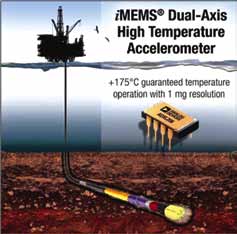
“While packaging, care must be taken to match the coefficient of hermal expansion between die, die-attach and substrate, so that the die is not stressed or fractured over cycles of wide temperature span,” suggests Choudhury.
Managing circuit design considerations: “Those designing circuits for high-temperature use must account for changes in IC parameters and passive components over a wide temperature range, paying close attention to their behaviour at the temperature extremes to ensure circuit operation within the target limits,” says Choudhury. They must analyse offset and input bias drift, gain errors, temperature coefficients,voltage ratings, power dissipation, board leakage and intrinsic leakage of other discrete devices. Often, high-temperature operation worsens board leakages due to contaminants such as solder flux,dust or condensation. Designers usually overcome such problems by using a proper layout that ensures adequate spacing between sensitive nodes.
Being put to good use
Using special techniques and engineering skills as discussed above, chip makers now offer full extreme temperature silicon chains for various verticals. Several components are available today, which are guaranteed to withstand extreme temperatures. Examples include high-precision temperature sensors (ranging from 1 to 0.25-degree accuracy), low-voltage programmable thermostatic switches, airflow and liquid flow sensors, digitally-programmable sensor signal amplifiers, instrumentation amplifiers, high-G micro-electromechanical accelerometers and gyroscopes, micro-processor supervisory circuits, signal processors, power management and data conversion systems, test instrumentation, and more. Let us take a look at some of these products available in the market.
Accelerometers. High-temperature accelerometers are available for vibration, speed and gravity measurement in industrial applications, geological down-hole exploration, etc. One such example is ADI’s ADXL206—a high-precision, low-power, dual-axis accelerometer that uses its integrated micro-electromechanical system (iMEMS) technology to integrate the sensor and signal-conditioned voltage outputs on a single, monolithic IC. It can measure both dynamic (vibration) and static acceleration (gravity) with an accuracy of 1mg resolution at 60 Hz. It is housed in an eight-lead side-brazed ceramic dual in-line package (SBDIP), and can stand operating temperatures of −40°C to +175°C, with a guaranteed 1000 hours life.
Instrumentation amplifiers. Companies like TI and ADI have high-temperature instrumentation amplifier for various applications. ADI’s AD8229 is an ultra-low noise instrumentation amplifier designed for measuring small signals in the presence of large common-mode voltages and at high temperatures in the range of 210°C. The process is dielectrically isolated to avoid leakage currents at high temperatures, and the design architecture compensates for the low base-emitter voltages at high temperatures.
Capable of measuring even tiny signals, the AD8229 is available in an eight-lead SBDIP. For space-constrained applications, there is also an eight-lead plastic standard small outline package (SOIC). It is used extensively for down-hole instrumentation, harsh-environment data acquisition, exhaust gas measurements and vibration analysis.

TI also has a range of high-temperature rated instrumentation amplifiers such as the INA128-HT, INA129-HT and INA333-HT, which can operate from -55°C to +210°C. TI’s high-temperature products utilise highly-optimised silicon (die) solutions with design and process enhancements to maximise performance over extended temperatures. The INA129 is available in an eight-pin ceramic dual inline package (DIP) and an eight-pin ceramic surface-mount package, specified for the –55°C to 210°C temperature range. The INA128 is available in an eight-pin small outline surface-mount package (SO8), specifiedfor the –55°C to +175°C temperature range.
Flash memory. TI has introduced what it claims to be the industry’s firt high-temperature 4MB Flash memory device. TI’s SM28VLT32-HT has an operating temperature ranging from -55°C up to +210°C, designed for data logging and firmware designs. It come in a small ruggedised packaging—14-pin ceramic flat package and KGD.
Consumer products are also now featuring temperature-tolerant memories, although the range is much lower than for critical applications. SanDisk, for example, is now promoting its Extreme SDXC UHS-I card and Extreme Pro MicroSDHC UHS-I 16GB card for use in cameras, video recorders, etc, and the Cruzer Glide USB Flash drive, which can be used in cold and hot weather spanning -25°C to +85°C.
Applications processor. One example of a high-temperature applications processor is TI’s OMAPL137-HT. It is a 300MHz dual-core (ARM926EJ-S and TMS320C674x DSP) applications processor designed for use from -55°C to +175°C, enabling harsh environment intelligent electronic processing. It runs a high-level, real-time operating system, and has robust 1.8V/3.3V peripherals (Ethernet MAC, EMIF 1/2, USB2.0 OTG, McASP). It comes in a 176-pin plastic quad-flat-pack package.






